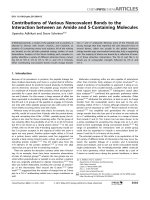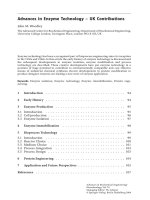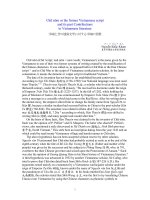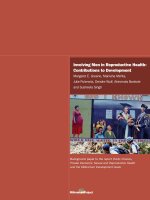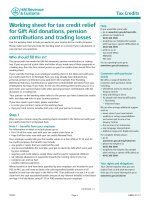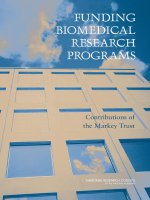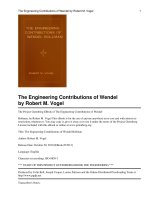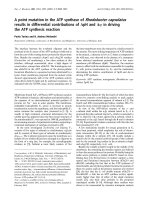DONGGOPMOI_(NEW CONTRIBUTIONS)
Bạn đang xem bản rút gọn của tài liệu. Xem và tải ngay bản đầy đủ của tài liệu tại đây (267.08 KB, 4 trang )
<span class='text_page_counter'>(1)</span><div class='page_container' data-page=1>
1
<b>THE NEW CONTRIBUTION OF THE DISSERTATION </b>
<b>Dissertation title: Utilization of locally available feed resources for increasing </b>
<i>performance and reducing enteric methane production of local yellow cattle in Lao PDR </i>
<b>Major: Animal Sciences </b>
<b>Code: 9620105 </b>
<b>Author name: Mr. Sangkhom Inthapanya </b>
<b>Supervisors: </b>
1. Associate Professor Dr Le Dinh Phung
2. Professor Dr Le Duc Ngoan
<b>Institutions: Hue University of Agriculture and Forestry </b>
<b>Contribution of the dissertation </b>
The research was aimed at utilizing of locally available feed resources for increasing
performance and reducing enteric methane production of local yellow cattle in Lao PDR.
There were five experiments presented on the dissertation. Experiments I, III and IV were
<i>to study gas and methane production in an in vitro rumen fermentation. Experiment II was </i>
to study intake, digestibility and N balance in local yellow cattle and finally, experiment V
was to study the growth rate and enteric methane production from local yellow cattle. This
is the first series of studies and the first scientific information in Laos on utilizing locally
available feed resources to manipulate rumen fermentation and thus to mitigate methane
emissions and at the same time to improve cattle performance.
Cassava roots fermented with urea, di-ammonium phosphate and yeast (specifically
<i>Saccharomyces cerevisiae) was used as an energy source. The cassava foliage was used as </i>
</div>
<span class='text_page_counter'>(2)</span><div class='page_container' data-page=2>
2
microbial communities capable of detoxifying the HCN when the cassava foliage was
consumed by the cattle.
<i>Total gas and methane production in vitro incubation was lower for the fermented </i>
cassava root, and then for the ensiled cassava root than for the dried root. In addition, total
gas and methane production was reduced when cassava leaf meal replaced water spinach
meal and when supplementing with brewers’ grains and rice distillers’ by-product.
Moreover, rice distillers’ by-product supplementation in substrate increased the
concentration of propionic acid in the rumen and reduced by 26% the ratio of methane to
carbon dioxide in the eructed rumen gas.
</div>
<span class='text_page_counter'>(3)</span><div class='page_container' data-page=3>
3
<b>NHỮNG ĐIỂM MỚI CỦA LUẬN ÁN </b>
<b>Tên luận án: SỬ DỤNG CÁC NGUỒN THỨC ĂN SẴN CÓ NHẰM TĂNG NĂNG </b>
<b>SUẤT VÀ GIẢM PHÁT THẢI KHÍ MÊTAN CỦA BỊ VÀNG ĐỊA PHƯƠNG Ở </b>
<b>CỘNG HOÀ DÂN CHỦ NHÂN DÂN LÀO </b>
Ngành: Chăn nuôi
Mã số: 9620105
<b>Tên NCS: Sangkhom Inthapanya </b>
<b> Người hướng dẫn: </b>
1. PGS. TS. Lê Đình Phùng
2. GS. TS. Lê Đức Ngoan
<b>Cơ quan: Trường Đại học Nơng Lâm, Đại học Huế </b>
<b>Những đóng góp của luận án </b>
Mục tiêu của nghiên cứu là đánh giá giá trị dinh dưỡng của một số thức ăn sẵn thông qua
sức sản xuất và chỉ số phát thải khí mêtan của bị vàng địa phương ở Cộng hồ Dân chủ
Nhân dân Lào. Nghiên cứu gồm 5 thí nghiệm được trình bày trong 5 chương của luận án.
<i>Thí nghiệm I, III và IV nhằm xác định sản lượng khí mêtan trong điều kiện lên men in vitro </i>
của các thức ăn. Thí nghiệm II xác định lượng ăn vào, tỷ lệ tiêu hoá và cân bằng N ở bị,
và cuối cùng, thí nghiệm V xác định sinh trưởng và sản lượng khí mêtan khi bị được cho
ăn các thức ăn địa phương. Đây là những nghiên cứu đầu tiên và cũng là những thông tin
lần đầu có ở Lào về sử dụng nguồn thức ăn địa phương để điều chỉnh sự lên men dạ cỏ từ
đó giảm phát thải khí mêtan và đồng thởi cải thiện năng suất của bò thịt.
<i>Củ sắn lên men với ure, diamon phốt phát và nấm men (Saccharomyces cerevisiae) </i>
được sử dụng làm nguồn thức ăn năng lượng. Trong khi, lá sắn sử dụng như nguồn protein
thoát qua (by-pass). Hàm lượng HCN trong củ và lá ảnh hưởng đến quá trình hình thành
mêtan trong dạ cỏ. Bả bia và hèm rượu cũng được sử dụng làm nguồn protein thốt qua và
cũng có vai trị như prebiotic giúp cộng đồng vi sinh vật dạ cỏ phát triển vì vậy tăng khử
độc HCN khi bị ăn thân lá sắn.
</div>
<span class='text_page_counter'>(4)</span><div class='page_container' data-page=4>
4
thay bột lá sắn thay thế lá rau muống và khi bổ sung bả bia và hèm rượu. Ngoài ra, bổ sung
hèm rượu vào cơ chất tăng hàm lượng axit propionic trong dạ cỏ và giảm 26% tỷ lệ
mêtan/cacbonic trong khí tiêu hố ở dạ cỏ.
</div>
<!--links-->
